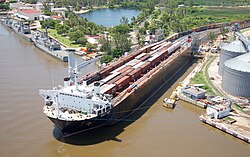Argentina
Nine train ferries were used between 1907 and 1990 to cross the Paraná river and join the Buenos Aires province (the main state in Argentina) and the Entre Rios province (the entrance to the Mesopotamian region), until new bridges were built over the rivers they crossed. They were Lucía Carbó (1907), María Parera (1908), Mercedes Lacroze (1909) (three ferries that operated between the ports of Zárate and Ibicuy (Entre Rios), crossing the Paraná River at the northwest of the Buenos Aires province). Then were added Roque Saenz Peña (1911) and Ezequiel Ramos Mejía (1913), paddle train ferries, at Posadas (crossing the Paraná River in the southwest of the Misiones province, at the north of the country, in the frontier with Paraguay).
Three other train ferries were added later: Dolores de Urquiza (1926), Delfina Mitre (1928) and Carmen Avellaneda (1929) to cover the service in the Zárate-Ibicuy crossing. María Parera had a collision with Lucía Carbó at km. 145 of the Paraná River, and it sank in less than 15 minutes on June 30, 1926. Two of the most modern still serve as floating piers in the Zárate region, and one of the first group was sunk during a storm at the Buenos Aires port in the 1980s. The two northern paddle ferries still remain at Posadas, and one of them holds a model railway museum inside. All the eight old ferries were built by the A & J Inglis, in Pointhouse, Glasgow, Scotland, for the Entre Rios Railways Co. in Argentina. The ninth ferry, Tabare, was built in Argentina by Astarsa in 1966 at Astillero Río Santiago Río Santiago Shipyard near to La Plata city. It was the largest train ferry that operated in Argentina, with a deck more than 100 meters long. Tabaré is still floating, but not operating, at the old south docks of Buenos Aires port, near the Puerto Madero zone.
Japan
In Japanese, a train ferry is called "鉄道連絡船 tetsudō renrakusen", which means literally "railway connection ship". Such ships may or may not be able to carry railcars. A ferry service that is part of a railway schedule and its fare system is called "tetsudō renrakusen".
Japan Railways linked the four main Japanese islands with train ferries before these were replaced by bridges and tunnels.
There were three ferry services that carried trains. Through operations of passenger trains using train ferries were conducted between December 1948 and 11 May 1955. The passenger services was canceled after the disasters of Toya Maru (26 September 1954, killed 1,153) and the Shiun Maru (11 May 1955, killed 168) occurred, after which the Japanese National Railways (JNR) considered it dangerous to allow passengers to stay on trains aboard ship. These three lines have been replaced by tunnels and bridges.
- The Seikan ferry connected Aomori Station and Hakodate Station crossing the Tsugaru Strait connecting Honshū and Hokkaidō. The first full-scale train ferry, Shōhō Maru, entered service in April, 1924. On 13 March 1988, the Seikan Tunnel was opened and the ferry ceased operation. The tunnel and the ferry line was operated simultaneously only on that day.
- The Ukō ferry connected Uno station and Takamatsu station crossing the Seto Inland Sea connecting Honshū and Shikoku. The ferry service started carrying railcars on 10 October 1921. On 9 April 1988, the Great Seto Bridge was opened and the last train ferry operated on the previous day.
- The Kammon ferry connected Shimonoseki Station and Mojikō Station crossing the Kanmon Strait connecting Honshū and Kyūshū. This was the first train ferry service in Japan starting operation on 1 October 1911. The train ferries used piers at Komorie station. After the completion of the Kanmon Tunnel on 1 July 1942, the service was discontinued and the ferries were transferred to the Ukō Ferry operation.








